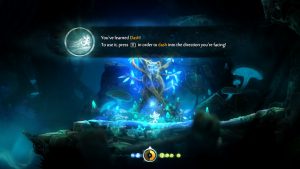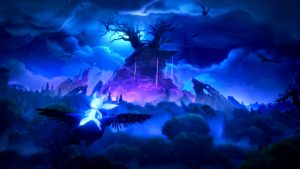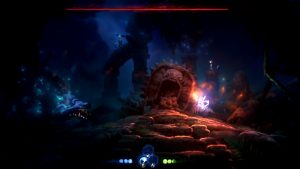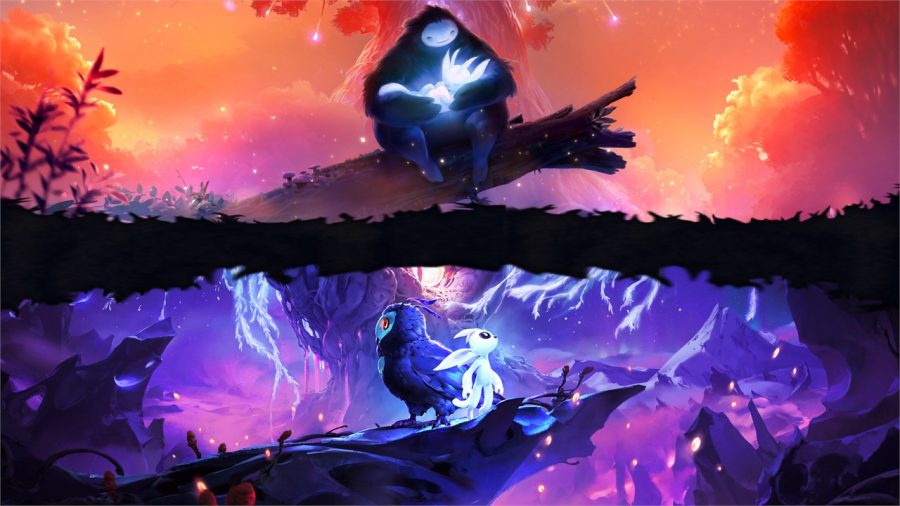An incredible indie experience: the Ori series
While indie game developers aren’t nearly as large as companies like Nintendo and Microsoft, some indie games can rival the most popular games in terms of quality and care. Carter McLaughlin ’23 takes a look at two indie games: “Ori and the Blind Forest” and “Ori and the Will of the Wisps.”
On March 11, 2015, the indie developers at Moon Studios released “Ori and the Blind Forest.” With the many awards it won, Moon Studios subsequently continued the Ori series five years later with “Ori and the Will of the Wisps.”
Both games are now available on Xbox One, Nintendo Switch and Steam, and I would say without a doubt that they’re worth the money. Without further ado, it’s time to take a look at “Ori and the Blind Forest,” starting with the story.

The Forest of Nibel is home to many wondrous species, one individual being the Spirit Tree. The Spirit Tree’s job is to maintain the three Elements of Light: the Element of Waters, the Element of Winds and the Element of Warmth.
One day, an incident known as the Great Storm blows away a single leaf off of the Spirit Tree, later to be revealed as Ori. As a means to reunite with Ori, the Spirit Tree holds the Light Ceremony, but the ceremony is interrupted by a being known as Kuro. With Kuro stealing the light of the Spirit Tree, it’s left to Ori to restore balance to Nibel.
Both Ori games are action-platformer games, but more specifically they’re ‘Metroidvania’ games. The Metroidvania genre follows two key aspects. The first is having one, interconnected world. The second is having the world slowly expand as the character is able to travel by finding new abilities spread across the map.

While starting off with only the initial abilities to run and jump, Ori later gains many more incredible abilities such as being able to wall jump and have the ability to bounce off enemies and projectiles. It’s amazing watching as Ori becomes stronger and faster through the course of the game.
The game encourages exploration with many secrets all around Nibel. Whether it’s the chance to find collectibles to upgrade Ori’s health hiding behind walls or a new ability, there’s always something to find around each corner. Even if something requires an ability that hadn’t been unlocked, it never felt like a hassle to return once I had the correct ability.
(Minor spoiler warning)
The game can be quite challenging at times, but it was never so difficult that it made me want to quit. One of the best instances of this comes from the escape sequences in the game. At first they’re a shock since they look more like a cutscene, but the escapes are easily one of the best things the series does.
The escape sequences never feel daunting, but rather encouraging. Rather than a timer on the screen and blaring lights warning the player’s time is running out, there’s instead music that motivates the player. Even if the player dies, the escape starts back up without the music going back to the beginning, almost as if the game itself wants the player to triumph.
(Spoilers end)
The rest of the game is equally as great, from the gameplay to the presentation. Playing as Ori feels smooth, and every action I did felt wonderful. The music perfectly captures the mood and the tone of the game; while the hand-painted art brings it all to life. When experienced firsthand, it’s clear to see the amount of effort put in by the developers.

When I first started playing “Ori and the Will of the Wisps,” I could immediately see things I thought were already incredible from the first game, and they were even better. The world Ori lives in feels brighter, and the new land of Niwen is even more vast and unique than Nibel.
When exploring Niwen, Ori initially doesn’t retain most of his abilities from the first game, but later on rediscovers them and obtains new ones along the way. The biggest introduction to Ori’s arsenal of skills is having access to more combat-oriented abilities such as the Spirit Edge being akin to a sword attack.
With all of the new abilities Ori has, the game splits them into skills and Spirit Shards. While skills are permanent abilities Ori can use either at all times or switch between, Spirit Shards are equippable upgrades that can range from gaining more total life to being able to deflect projectiles.
This allows for several different ways to play the game, with there being a total of 31 Spirit Shards and 20 different skills Ori unlocks through the course of the game. While I used abilities mainly for movement and exploration, another player could use set-ups to play in a very high risk, high reward style.

One last detail that adds to the game is the introduction of a quick access menu. With it, the player can re-experience major parts of the game like boss battles without having to go through the entire game again. It’s a minor addition, but it makes a world of difference to be able to go back to the most intense parts of the game.
Overall, I easily give the Ori series a 10/10. From the story, the gameplay and the presentation, the Ori series was one of the most enjoyable I’ve played recently. I would recommend it to anyone who is able to purchase the games. With news of a new game being developed by Moon Studios, I am looking forward to what they will make next.
Your donation will support the student journalists of West High School. Your contribution will allow us to purchase Scholarship Yearbooks, newsroom equipment and cover our annual website hosting costs.

Carter McLaughlin is a sophomore at West High. This is his first year as an online staff reporter. In his free time, you can expect him to be on his Nintendo...



